
About Navratri
The Indian festival of Navratri has been derived from two words—”Nav” + “Ratri”, which means “nine nights” in English. This festival is prevalent throughout India, but it is more prominent in the state of Gujarat and Bengal. Hindus celebrate this festival to express their devotion to the goddess of power, Durga. The worship of the goddess Durga continues for nine days. Each day, a different form of the goddess is worshiped. Following the nine days of rituals and worship, the 10th day is celebrated as Dussehra, which is also known as Vijay- Dashmi. It is celebrated to mark the victory of mythical King Lord Rama over the King of Sri Lanka, Ravana.
What is the celebration of Navratri?
Navratri or the festival of nine nights is celebrated with full fervor and enthusiasm in the Indian subcontinent. The festival is celebrated with devotion for a period of 10 days in India. Though the festival is of nine nights the festivity gets stretched top the tenth day. It is on the tenth day on which the idol of Goddess Durga is immersed in the holy water after worshipping. Different forms of the goddess are worshipped for nine days to enhance the physical, spiritual and mental well-being. As per the Hindu calendar Navaratri occurs during the month of Ashvin in the early autumn.
What is the story of Navratri?
There are several stories related to Navratri but there are two stories which are the most prevalent ones. Mahishasura, a demon worshipped Lord Shiva with full devotion. The lord got so impressed by his great dedication that he gave him a boon to not get killed either by man or by God. After getting a boon of eternity Mahishasura became proud and arrogant. He unleashed a reign of terror everywhere and created problems for everybody. He didn’t stop there and further initiated an attack on heaven which now scared the Gods too. Several Gods assembled and tried to fetch a remedy to get rid of nuisance of Mahishasura. Finally, a solution was obtained by creating a new Goddess by amalgamating the powers of all the male Gods. Mahishasura kept hiding and disguising himself for nearly 8 days but it was on 9th day that Maa Durga was able to find him and slew his head.
Maa Durga represented the good and Mahishasura represented the evil. So, the killing of the demon Mahishasura is celebrated as the victory of Good over evil.
The other story associated with the festival is of Lord Rama and Ravana. Lord Rama was a worshipper of Devi Bhagwati, the supreme power. He worshipped her for nine consecutive nights to emerge victorious over Ravana in the Dharm Yuddh. On the ninth day, Lord Rama proved his devotion to the devi and it was on the tenth day he emerged victorious after killing Dashanan (Ravana). Since then different incarnations of Devi Bhagwati are worshipped and it is on the tenth day Vijaya Dashmi is celebrated.
In which states is Navratri celebrated?
From north to south, west to east Navratri is celebrated all over India by different names.
In Eastern India and West Bengal, Navratri dominates the religious life of the people. In fact, Navratri is the most important festival for Bengali Hindus. All the streets and corners are decorated and pandals are being made for celebrating Durga Puja. The different incarnations of Goddess Durga are worshipped for nine days and on the tenth day a great procession is held wherein the statue is immersed in the holy river. At some places, people play with vermillion and distribute sweets and gifts.
In Gujarat, devotees observe fasts and worship different forms of Maa Durga for nine days. There are celebrations on a large scale starting from the last 5 days of Navratri. Garba is performed during Navratri with dandiya sticks and there is fun and frolic all around.
In Bihar, festive celebrations and performance arts are held at local temples. A great Navratri fair is arranged in Sitamarhi in Bihar. There are large displays of handicrafts, pottery, kitchen and houseware which attracts a large bunch of tourists.
In Delhi and Uttar Pradesh, Navratri celebrations are marked by Ramlila performances. Stage shows are held which are great, grand and spectacular. The Ramlila shows draw to close on Dashmi, i,e on the tenth day. It is on this day when the effigies of Ravana are burnt.
In other states of India including Punjab, Maharashtra, Kerala, Himachal Pradesh, Navratri is celebrated with full fervor and enthusiasm. Durga Pujas are arranged and people celebrate by performing various dance forms, making delicious cuisines, decorating their localities, and taking out processions of idols of gods and goddesses. Celebrations are held all over the country.
What is the importance of Navratri?
Among the several festivals in India, Navratri has great importance. The festival signifies the victory of good over the evil and is celebrated with full enthusiasm. The nine days of Navratri are one of the most religious days as people forbid all unlawful practices and perform religious ceremonies. The festival of Navratri symbolizes the journey of humanness to divinity. The aim of celebrating this festival is to remind people of the real goals of human life and also make them understand the value of doing good and condemning evil.
Navratri Celebrations Events
| Navratri Day | Day | Form of Goddess | Pujan | Colour |
|---|---|---|---|---|
| Navratri Day 1 | Pratipada | Shailaputri Maa | Shailputri Pujan | Red |
| Navratri Day 2 | Dwitiya | Bharmacharini | Brahmacharini Pujan | Royal Blue |
| Navratri Day 3 | Tritiya | Chandraghanta | Chandraghanta Pujan | Yellow |
| Navratri Day 4 | Chaturthi | Kushmanda | Bhouma Chaturthi | Green |
| Navratri Day 5 | Panchami | Skandamata | Skandamata Pujan | Gray |
| Navratri Day 6 | Shashthi | Katyayani | Saraswati Awahan, Katyayani Pujan | Orange |
| Navratri Day 7 | Saptami | Kaalratri | Saraswati Puja, Kalaratri Pujan, Utsava Puja |
White |
| Navratri Day 8 | Ashtami | Maha Gauri | Saraswati Mata Pujan, Mahagauri Pujan, Sandhi Puja | Pink |
| Navratri Day 9 | Navami | Siddhidatri | Ayudha Puja, Kanya puja |
Sky Blue |
Types of Navratri:
4 Different Navratris
| Navratri | Timing |
|---|---|
| Vasanta Navaratri | March–April |
| Ashad Navaratri | June–July |
| Sharad Navaratri | September–October |
| Pausha/Magha Navaratri | December–January |
Rituals:
- The two famous rituals are called as “Paath” and “Durga Aarti.” An Aarti is an ancient practice of singing hymns as part of the worship of the goddess.
- The ninth day is also marked as Raam Navmi, a famous Festival, when stage shows and plays are organized throughout India to depict the story of Lord Rama. On ninth day, the worshipers bid farewell to the goddess Durga. It is followed by the ritual of “kanya-pujan,” when the little girls are worshiped, and offered food and sweets.
- The Festival is celebrated differently according to the region. For example in North India, the festival continues for nine long days, when fasting and worshiping continues almost every day. However, in the state of West Bengal, only the last four days are celebrated as Durga- Pooja.
- In the western state of Gujarat, it is celebrated with much fun and fervor, where the most popular local dances Garba and Dandiya- Raas are performed by both men and women.
- Men and women get dressed in colorful clothes and perform the dance together in open areas all night long. In the other states such as Kerala, Karnataka, Andhra Pradesh and Rajasthan, the rituals vary greatly.
Puja Samagri for the Navratri Puja
- Picture or Idol of Goddess Durga in the Pooja room
- Chunri
- Durga Saptshati book
- Moli, red sacred thread
- Ganga water or plain water in Kalash (pitcher)
- Fresh mango leaves
- Rice
- Sandalwood
- One coconut
- Roli, red sacred powder for tilak
- Fresh grass
- Gulal
- Supari
- Paan
- Cloves
- Cardamom
- Kumkum
Navratri Mantra
Navratri Day 1 Mantra – Mata Shailputri Mantra
वन्दे वाञ्छितलाभाय चन्द्रार्धकृतशेखराम्। वृषारुढां शूलधरां शैलपुत्रीं यशस्विनीम्॥
Navratri Day 2 Mantra – Devi Brahmcharini Mantra
दधाना करपद्माभ्यामक्षमालाकमण्डलू। देवी प्रसीदतु मयि ब्रह्मचारिण्यनुत्तमा॥
Navratri Day 3 Mantra – Mata Chandrghanta Mantra
पिण्डज प्रवरारूढ़ा चण्डकोपास्त्रकैर्युता। प्रसीदम तनुते महयं चन्द्रघण्टेति विश्रुता।।
Navratri Day 4 Mantra – Mata Kushmanda Mantra
वन्दे वांछित कामार्थे चंद्रार्घ्कृत शेखराम, सिंहरुढ़ा अष्टभुजा कुष्मांडा यशस्वनिम.
Navratri Day 5 Mantra – Devi Skanda Mantra
सिंहासनगता नित्यं पद्माश्रितकरद्वया. शुभदास्तु सदा देवी स्कन्दमाता यशस्विनी
Navratri Day 6 Mantra – Mata Katyayani Mantra
स्वर्णाआज्ञा चक्र स्थितां षष्टम दुर्गा त्रिनेत्राम्। वराभीत करां षगपदधरां कात्यायनसुतां भजामि॥
Navratri Day 7 Mantra – Mata Kalratri Mantra
करालवंदना धोरां मुक्तकेशी चतुर्भुजाम्। कालरात्रिं करालिंका दिव्यां विद्युतमाला विभूषिताम॥
Navratri Day 8 Mantra – Maha Gauri Mantra
पूर्णन्दु निभां गौरी सोमचक्रस्थितां अष्टमं महागौरी त्रिनेत्राम्।
वराभीतिकरां त्रिशूल डमरूधरां महागौरी भजेम्॥
Navratri Day 9 Mantra – Siddhi Datri Mantra
स्वर्णावर्णा निर्वाणचक्रस्थितां नवम् दुर्गा त्रिनेत्राम्।शख, चक्र, गदा, पदम, धरां सिद्धीदात्री भजेम्॥
Navratri Facts
One of the most auspicious Hindu festival is Navratri and it is is dedicated to the worship of ‘Durga Maa’.Dgreetings offers a great collection of interesting facts about the holy Navratri festival to acquaint to enhance your knowledge about it.
1- “Navaratri” – The word is a combination of two words- nava (meaning nine) and ratri (meaning night).i.e. Nine nights and is observed for nine days.
2- Navaratri or Durga Pooja is observed twice a year for nine days each.
3- Each of nine days signify one of the nine forms of Goddess Shakti: Durga, Bhadrakali, Jagadamba, Annapurna, Sarvamangala, Bhairavi, Chandika, Lalita, Bhavani and Mookambika.
4- Sharad navratri devotes three days each for the worship of three different forms of Maa Shakti – Goddess Durga (first three days), Goddess Lakshmi (fourth to sixth day) and Goddess Saraswati (last three days).
5- The three main Navratri that are celebrated in India are: Sharad Navratri, Vasant Navratri and Ashada Navratri.
6- Sharad Navratri is most important of the Navratri festivals. It is celebrated at the start of winters i.e. Sharad season (month of September/October), and celebrates the slaying of Mahishasura by Goddess Durga.
7- The dates of the Navratri are set as per the lunar calendar. Observerd at the start of summers and onset of winters.
8- The tenth day of Sharad Navratri , which is Vijayadashami is celebrated as Dusshera festival.
9- Vasant Navratri is celebrated during the start of summers i.e. Vasant season (months of March/ April), and is celebrated in North India.
10- A shada Navratri is celebrated in the state of Himachal Pradesh during the Ashada season (i.e. Months of July-August)
Source : www.dgreetings.com

